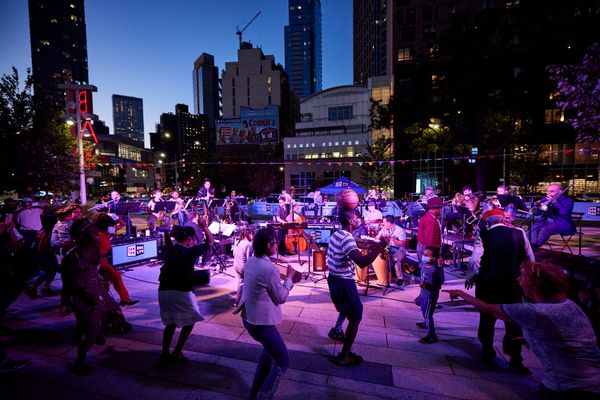Should Kagan or Brannan Represent Bay Ridge and Coney Island in City Council?
Ahead of the November 7 local elections, when we get to pick our city council members again, NY1 held a debate Tuesday night (you can watch it here) between the two incumbents in what will be the new District 47 – Ari Kagan, a recent Republican representing current Council District 47, and Justin Brannan, a Democrat representing current Council District 43. Following the 2020 Census, all council districts were redrawn, putting Brannan's residence in the new District 47 and pitting two incumbent council members against each other in a district that now includes Bay Ridge and Coney Island, with a sliver of Bath Beach connecting the two.
The biggest difference between the two candidates wasn't policy, but politics: Kagan accused Brannan of wanting to defund the police, and dodged a question about whether he'd support Donald Trump over Joe Biden. Brannan accused Kagan of flirting with Islamaphobia, even as both denounced Hamas attacks on Israel.
Kagan and Brannan need to convince voters unaffiliated with a party to show up and vote for them, and in Kagan's case – to win over as many moderate Democrats or Democrats in name only as he can, which puts them both smack in the center politically – a little to the right or a little to the left, and fundamentally similar when it comes to what a councilmember can do to serve their district, except that it generally helps to be in the majority to get stuff done.
The turnout is not expected to be as high as in the general election when 40% of voters showed up at the polls. In off years, that number tends to drop by at least a half. Notably, in the last election, votes of the new district's residents, as analyzed by THE CITY, were split evenly between Democrats and Republicans, despite 50% of voters being registered as Democrats and just 18% as Republicans.
Brannan, who's been in office since 2018, lists among his most significant accomplishments investments in seven new schools, spending $70 million on parks, funding renovations of a senior center, and bringing a new medical facility to the community.
Kagan, elected in 2022, leans into his immigrant background and work in the community, blames the current crises from housing to mental health to migrants on the socialist, progressive-leaning of the Democrats in power, and asks for votes from residents who don't like the status quo.
So what happened at the last night's debate?
Errol Louis moderated the NY1 debate and started with a question on their takes on the war between Israel and Hamas. The new district contains a significant Palestinian community in Bay Ridge and many descendants of Holocaust survivors on the Coney Island side. Kagan strongly condemned Hamas and those at the last Saturday's protest in Bay Ridge with anti-Israel and anti-American slogans and chants, and called for a peaceful solution. Brannan similarly condemned Hamas, noting that foreign policy is not a local issue and there is little a local council member can do but to help as much as possible local communities live in peace and bring people together. The NYT has a more in-depth story on the protest and tensions in the two communities locally.
The conversation then moved to migrant shelters. Neither Brannan nor Kagan wants migrant shelters in the community, and both want the federal government's help dealing with (and paying the city back). Brannan wants TPS (Temporary Protected Status that allows work) expanded, saying, "migrants didn't come here for a free hotel room. They came here seeking asylum and looking to make a better life for themselves."
Kagan wants the southern border closed and legal immigration options expanded. He offered himself as an example of a refugee who had to follow a lengthy process to be allowed into the country, and said it was harder to bring a family member legally than to cross the border without papers.
Regarding funding, Brannan said that "our compassion as New Yorkers is unlimited, but our resources are not."
"You should not spend billions and billions of New York City taxpayers' money on opening more migrant shelters on migrant services and creating more incentives" at the cost of potentially cutting services to residents, Kagan argued, saying that it will only bring more migrants to the city.
Neither offered concrete solutions within a council member's powers to improve the current situation or what to do with those that keep arriving.
Then the conversation moved to Local Law 97, also known as the sustainable buildings law, which aims to significantly reduce carbon emissions across the city (40% by 2030 and 80% by 2050) – effectively requiring all large buildings, including many co-ops and condos (but not NYCHA) to undertake costly improvements or face fines. Louis asked whether the council members support pushing back the date of compliance.
Brannan wants to "incentivize and encourage" building owners to make the improvements and use the fines to fund improvements, Kagan wants the date when penalties kick in pushed back by seven years. Both want help from the government to pay for these improvements.
Next up - crime. There was a lot of back-and-forth, but the main takeaway is that traditional public safety improvements (more cops, patrols, cameras, and anti-gun violence programs) seem to be high on Kagan's list. Brannan said his district has more cops now than when he was elected, and argued that public safety needs to be a holistic approach.
"No victim or witness to a crime wants to hear about statistics that New York has never been safer," Brannan said. "They want to be understood. They want empathy, and they want you to work with them to make them feel safe again."
Data: I looked at the Compstat, the city's crime statistics, and as of this week, in the 68th Precinct, which covers Bay Ridge, robberies are up 30% compared to this time last year, felony assaults are up 22%, while all together, major crimes are down 5%. In the 60th Precinct, which includes Coney Island, robberies are down 12%, and assaults are down 2%. The most significant drop has been in shootings - down 75% this year. All major crimes together were down 12%. Hate crimes are up in both precincts, going from 1 to 7 in the 68th and 6 to 10 in the 60th. Per resident, crime is lower in Bay Ridge, but that does not take into account the massive seasonality of visitors to Coney Island, so the numbers are a bit hard to compare.
Last up was housing – the city badly needs more housing, so what kind of housing and where would the council members like to see in the district?
"We need to build more housing that people can actually afford at all income levels, which is why I led the charge to pass the law to create the office to conversion, affordable housing conversion task force that now we could create 40,000 new units of affordable housing by converting vacant office space. So I am open to development as long as the people can afford it at all income levels," Brannan said. Asked if those conversions would be in his district he said, no, mostly Manhattan.
Kagan focused on the NYCHA Accountability Act, which would hold NYCHA property managers to account, demanded an audit of the agency, and noted the many affordable housing projects opening in his district.
Data: According to the New York Housing Conference's recent report, just 118 affordable were built in Brannan's district between 2014 and 2022, while over 1,523 were built in Kagan's.





